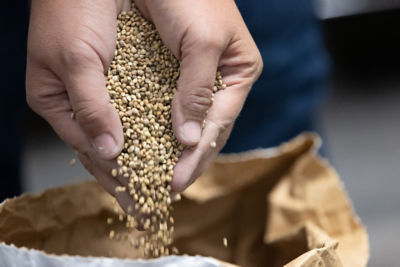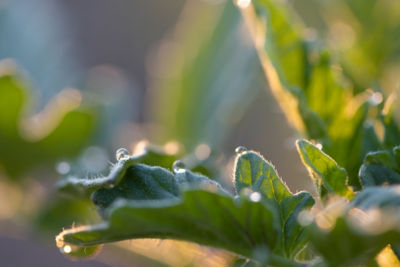Click here to download a PDF version of this spotlight.
» Weed control in vegetables grown on plastic mulch is often more complex than with non-mulched vegetable systems.
» Weed management under the plastic, in the plant holes, and in the non-mulched areas must be considered separately.
Plastic mulches are used in many commercial vegetable operations to promote early growth and help increase yield potential. Weed management in plasticulture systems is more complex because there are three areas (under the plastic, plant holes in the plastic, and non-mulched areas between beds) where weed control is needed (Figure 1).1,2 Also, there are fewer herbicide control options, cultivation between rows is more difficult, and there can be a greater potential for crop injury.1
Season length and canopy structure should be considered in weed management decisions.
Long-season crops (melon, pepper, tomato, and watermelon) can require three to four months of weed control. Weed management strategies feasible in a field of staked tomatoes may not be possible in a watermelon field during the vining stage.3
MULCHES
Plastic mulches are often used to increase soil temperatures and stimulate early-season crop growth, but they can also provide weed control within the plant rows.4 Black plastic is good at suppressing weed growth because it blocks sunlight that stimulates the germination of some weed seeds and is needed for photosynthesis. Many annual weed species are suppressed under black plastic. However, the warm, moist conditions under the mulch can stimulate the germination of yellow nutsedge. Also, the light, which typically stops the upward growth and initiates leaf formation, is absent, which allows nutsedge to continue upward growth, resulting in them piercing the mulch layer.2
Sunlight penetrates clear and white (but not white on black) mulches, allowing weeds to grow under the plastic. Clear mulch can result in greater soil heating, but it does not control weeds. Colored and IR mulches provide some of the additional soil warming benefits but block the wavelengths of light used for photosynthesis, resulting in better weed control.1,2
 Figure 1. Weed growth between mulched beds.
Figure 1. Weed growth between mulched beds.
WEED CONTROL UNDER PLASTIC MULCH
Optimizing weed control under mulch requires good soil preparation. It is best to apply herbicides after forming beds but before laying the mulch. However, this can be difficult when using equipment that shapes beds and lays plastic in one pass. It is best if soil-incorporated herbicides are applied and incorporated AFTER bed formation but before laying the mulch. Incorporating herbicides before bed formation can result in higher than recommended rates of herbicides in the bed soil and herbicides incorporated too deeply in the soil, resulting in crop injury.1,2 Also, applying herbicides to the entire field before laying the mulch can result in breaks in the weed barrier at the edges of the mulch strip when the soil is tilled to bury the plastic mulch.
Some references state that overhead irrigation or rainfall of at least 0.5 inches is needed to activate the herbicides under the mulch. Others indicate that the condensation that forms under the mulch is often enough to activate herbicides.1,2 It is possible that the volatilization of herbicides under the mulch can result in crop injury. Growers should consult product labels for recommendations or restrictions related to the use of herbicides with plastic mulch and conduct small-scale tests before large-scale applications to help avoid crop injury. Soil fumigants applied through drip irrigation can provide good weed control, depending on the products used and weed species present. The wet edge of the irrigation front should reach the sides of the bed to ensure complete coverage.2
WEED MANAGEMENT IN PLANT HOLES
Controlling weeds that emerge from plant holes can be difficult (Figure 2). Herbicides applied under the plastic can provide some control, but sunlight reaching the soil in these holes may allow weeds to germinate and grow. Removing weeds by hand is often the best option for plant holes. Weeds growing in plant holes can affect some crops more than others. A North Carolina study found that tomatoes were not substantially affected by weeds growing in the holes, while melons showed a 40% yield reduction and peppers showed a 73% reduction.1
 Figure 2. Common purslane growing in a plant hole in plastic mulch.
Figure 2. Common purslane growing in a plant hole in plastic mulch.
WEED MANAGEMENT BETWEEN BEDS
Weeds also need to be managed in the non-mulched areas between beds. Management options in this area include herbicides, cultivation, mowing, and dead and living organic mulches. The stale bed, pre-emergence, and post-emergence stages of weed management all need to be considered.
Herbicides can be applied to the inter-row areas as stale bed treatments. Care needs to be taken if applying pre-plant herbicides before laying plastic for the reasons mentioned above. Broadcasting pre-plant herbicides over the whole field after the mulch has been laid is also not recommended. Herbicides applied to the mulch can be washed into plant holes with rain or overhead irrigation, resulting in herbicide concentrations substantially higher than what is recommended.1,2 Soils treated with herbicides also should not be used to mound around emerged seedlings or transplants.
When possible, lay mulches several weeks before planting or transplanting to allow weed seeds to germinate. Cultivation and banded applications of herbicides, such as glyphosate and paraquat, can be used as stale bed treatments. Check product labels for timing restrictions and allowed crop uses.1,2,3 These types of herbicides will not provide any residual weed control.
Cultivation or subsequent banded herbicide treatments will likely be needed to help manage weeds as the season progresses. Cultivations should be shallow to prevent bringing up weed seeds deeper in the soil profile. Post-emergence herbicides should not be applied to the plastic mulch because they can wash into the plant holes and may cause crop injury. Banded applications should be made with fully shielded sprayers (front, back, and sides) to prevent the herbicides from coming into contact with the cash crop. Backpack or handheld sprayers can also be used for targeted applications. Applications should be made when wind speeds are low to help prevent drift. Targeted sprays or hand weeding may be required at the edges of the plastic mulch.1 Glyphosate and other translocated herbicides should not be used for post-emergence treatments because contact with any part of the plant can result in injury to the whole plant or plant death.
MOWING, ORGANIC MULCHES, COVER CROPS
Researchers, extension specialists, and growers have been evaluating the use of organic mulches, mowing weeds, and planting cover crops between rows to manage weeds in plasticulture systems. While showing some promise, evaluations have shown that these forms of management may not provide adequate control. A Delaware-based study evaluated the use of living mulches (cover crops) between rows in plasticulture watermelon systems for weed management. Results showed that living mulches could lower total weed biomass between the rows. However, they did not adequately manage weeds or eliminate the need for other forms of weed control.5 Other studies have found that cultivation and dead organic mulch provided better weed control than living mulches or the mowing of weeds between rows.4 The presence of living mulches and mowed weeds were also associated with yield reductions of some types of crops in some years of the study. It was hypothesized that the living mulches and mowed weeds may compete with the cash crop for resources such as nitrogen and water. Using living mulches, dead mulches, and weed mowing treatments may have additional benefits, such as protection against soil erosion, adding organic matter to the soil, and the increased biodiversity of the system.
CONSIDERATIONS
Weed management in plasticulture systems is complex, and growers should start planning early and carefully consider the various options available. Check regional production and pest management guides for recommendations on herbicides for specific crops and weed species. Not all herbicides can be used under plastic mulch, so growers should consult product labels for application recommendations and restrictions. When treating selected areas, such as under plastic mulch or only non-mulched areas, acreage calculations need to be adjusted. For example, in a system with 30-inch mulched beds and 30-inch inter-row areas, only half of the total field area will be treated during applications to under-mulch or between-row areas. Therefore, only half of the amount of herbicide will be needed. Residual herbicides may be difficult to use if different crops are grown in a small area. When treating row middles between two different crops, the herbicide selected must be registered for use on both crops.1,2,3
SOURCES
1 Bonanno, A. R. 1996. Weed management in plasticulture. HortTechnology 6:186-189.
2 Besancon, T. 2022. Recommendations for under plastic mulch weed control. Rutgers Plant & Pest Advisory. July 9, 2022.
3 Quinn, J. 2020. Peemergent herbicides for aisles between plastic covered beds. Integrated Pest Management, University of Missouri. https://ipm.missouri.edu/MPG/2020/2/plasticMulch/.
4 Tarrant, A. and Hayden, Z. 2019. Optimizing between-bed management strategies in plasticulture vegetables for improved crop production and soil health. https://projects.sare.org/project-reports/gnc17-251/.
5 Vollmer, K. and VanGessel, M. Integrating cover crops for weed management in plasticulture systems. https://www.udel.edu/academics/colleges/canr/cooperative-extension/sustainableproduction/weed-science/.
Websites verified 7/26/2022
ADDITIONAL INFORMATION
For additional agronomic information, please contact your local seed representative.
Performance may vary from location to location and from year to year, as local growing, soil and weather conditions may vary. Growers should evaluate data from multiple locations and years whenever possible and should consider the impacts of these conditions on the grower’s fields. The recommendations in this article are based upon information obtained from the cited sources and should be used as a quick reference for information about vegetable production. The content of this article should not be substituted for the professional opinion of a producer, grower, agronomist, pathologist and similar professional dealing with vegetable crops.
BAYER GROUP DOES NOT WARRANT THE ACCURACY OF ANY INFORMATION OR TECHNICAL ADVICE PROVIDED HEREIN AND DISCLAIMS ALL LIABILITY FOR ANY CLAIM INVOLVING SUCH INFORMATION OR ADVICE.
5023_49501 Published 08/09/2022
Bayer, Bayer Cross, and Seminis® are registered trademarks of Bayer Group. All other trademarks are property of their respective owners. © 2022 Bayer Group. All rights reserved.



